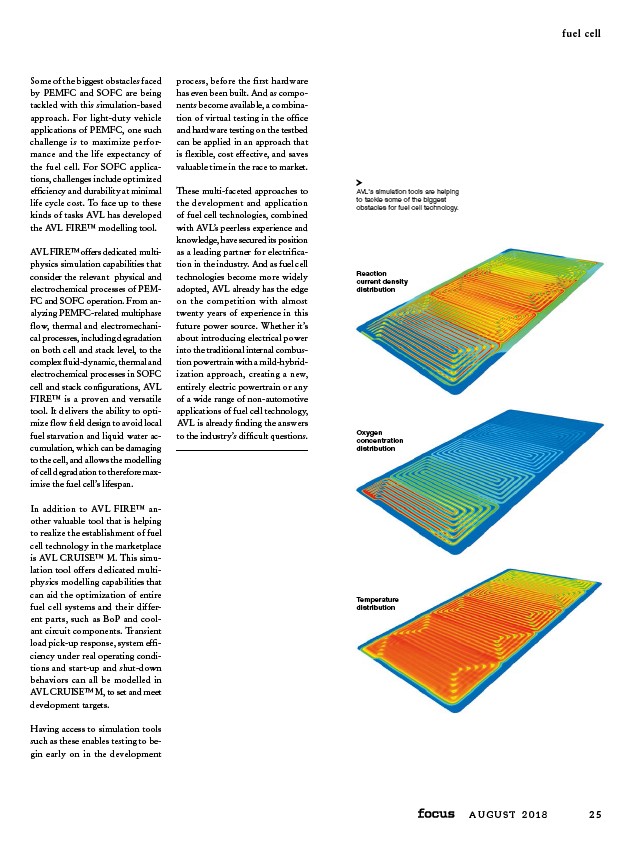
fuel cell
A U G U S T 2 0 1 8 2 5
Some of the biggest obstacles faced
by PEMFC and SOFC are being
tackled with this simulation-based
approach. For light-duty vehicle
applications of PEMFC, one such
challenge is to maximize performance
and the life expectancy of
the fuel cell. For SOFC applications,
challenges include optimized
efficiency and durability at minimal
life cycle cost. To face up to these
kinds of tasks AVL has developed
the AVL FIRE™ modelling tool.
AVL FIRE™ offers dedicated multiphysics
simulation capabilities that
consider the relevant physical and
electrochemical processes of PEMFC
and SOFC operation. From analyzing
PEMFC-related multiphase
flow, thermal and electromechanical
processes, including degradation
on both cell and stack level, to the
complex fluid-dynamic, thermal and
electrochemical processes in SOFC
cell and stack configurations, AVL
FIRE™ is a proven and versatile
tool. It delivers the ability to optimize
flow field design to avoid local
fuel starvation and liquid water accumulation,
which can be damaging
to the cell, and allows the modelling
of cell degradation to therefore maximise
the fuel cell’s lifespan.
In addition to AVL FIRE™ another
valuable tool that is helping
to realize the establishment of fuel
cell technology in the marketplace
is AVL CRUISE™ M. This simulation
tool offers dedicated multiphysics
modelling capabilities that
can aid the optimization of entire
fuel cell systems and their different
parts, such as BoP and coolant
circuit components. Transient
load pick-up response, system efficiency
under real operating conditions
and start-up and shut-down
behaviors can all be modelled in
AVL CRUISE™ M, to set and meet
development targets.
Having access to simulation tools
such as these enables testing to begin
early on in the development
AVL's simulation tools are helping
to tackle some of the biggest
obstacles for fuel cell technology.
Reaction
current density
distribution
Oxygen
concentration
distribution
Temperature
distribution
process, before the first hardware
has even been built. And as components
become available, a combination
of virtual testing in the office
and hardware testing on the testbed
can be applied in an approach that
is flexible, cost effective, and saves
valuable time in the race to market.
These multi-faceted approaches to
the development and application
of fuel cell technologies, combined
with AVL’s peerless experience and
knowledge, have secured its position
as a leading partner for electrification
in the industry. And as fuel cell
technologies become more widely
adopted, AVL already has the edge
on the competition with almost
twenty years of experience in this
future power source. Whether it’s
about introducing electrical power
into the traditional internal combustion
powertrain with a mild-hybridization
approach, creating a new,
entirely electric powertrain or any
of a wide range of non-automotive
applications of fuel cell technology,
AVL is already finding the answers
to the industry’s difficult questions.